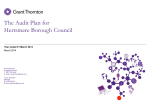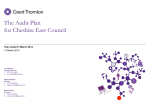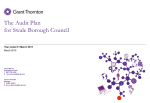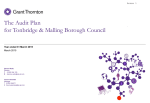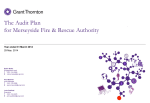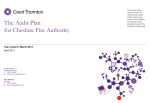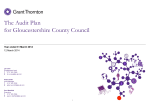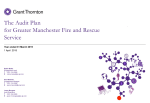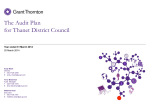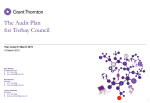Download The Audit Plan – template user guide
Transcript
The Audit Plan for Tunbridge Wells Borough Council Year ended 31 March 2014 June 2014 Darren Wells Director T +44 (0)1293 554 120 E [email protected] Richard Smith Manager T +44 (01293 554 101 E [email protected] Graham Short Executive T +44 (01293 554 088 E [email protected] © 2014 Grant Thornton UK LLP | The contents of this report relate only to the matters which have come to our attention, which we believe need to be reported to you as part of our audit process. It is not a comprehensive record of all the relevant matters, which may be subject to change, and in particular we cannot be held responsible to you for reporting all of the risks which may affect the Council or any weaknesses in your internal controls. This report has been prepared solely for your benefit and should not be quoted in whole or in part without our prior written consent. We do not accept any responsibility for any loss occasioned to any third party acting, or refraining from acting on the basis of the content of this report, as this report was not prepared for, nor intended for, any other purpose. Contents Section 1. Understanding your business 2. Developments relevant to your business and the audit 3. Our audit approach 4. Significant risks identified 5. Other risks 6. Results of interim work 7. Value for Money 8. Logistics and our team 9. Fees and independence 10. Communication of audit matters with those charged with governance © 2014 Grant Thornton UK LLP | Understanding your business In planning our audit we need to understand the challenges and opportunities the Council is facing. We set out a summary of our understanding below. Challenges/opportunities 1. Promoting a prosperous borough 2. A Green Borough 3. A confident Borough The Council aims to deliver employment opportunities, support improvements to the internet and roads and improve the vitality of the town centre The Council aims to improve the environment, continue to cut waste and help reduce energy consumption through a variety of planning, development and green initiatives. The Council has developed a number of work-streams to support the Community and widen community engagement including, devolution of services to parish and town councils, development of youth and cultural activities. Our response We will discuss the Council's plans for regeneration, business growth and the opportunity for our wider firm specialists to help the Council and local companies through the Growth Accelerator scheme. Where the Council's plans impact on the accounts for instance through grants, capital or revenue expenditure we will consider the impact on our audit. © 2014 Grant Thornton UK LLP | We will conduct our audit in a sustainable way, utilising our software package 'Voyager' to minimise the need for hard copy documents. We will attend and speak at Council meetings that are relevant to our audit role. We will seek to minimise travel and energy consumption. Our audit reports are published and are made available to the public on the Councils' website. Where the Council's plans impact on the accounts for instance through grants, capital or revenue expenditure we will consider the impact on our audit. We will discuss the Council's plans for alternative service delivery models as part of our audit planning and value for money conclusion. Developments relevant to your business and the audit In planning our audit we also consider the impact of key developments in the sector and take account of national audit requirements as set out in the Code of Audit Practice ('the code') and associated guidance. Developments and other requirements 1.Financial reporting 2. Legislation 3. Corporate governance 4. Pensions 5. Financial Pressures 6. Other requirements Changes to the CIPFA Code of Practice Local Government Finance settlement Annual Governance Statement (AGS) Managing service provision with less resource Clarification of Code requirements around PPE valuations Welfare reform Act 2012 Explanatory foreword The impact of 2013/14 changes to the Local Government pension Scheme (LGPS) from 1 April 2014 The Council is required to submit a Whole of Government accounts pack on which we provide an audit opinion Progress against savings plans The Council completes grant claims and returns on which audit certification is required Changes to NDR accounting and provisions for business rate appeals Our response We will ensure that the Council complies with the requirements of the CIPFA Code of Practice We have discussed the changes to requirements for PPE valuations with officers We are alert to business rate appeals through discussions with management and our substantive testing © 2014 Grant Thornton UK LLP | We will discuss the impact of the legislative changes with the Council through our regular meetings with senior management and those charged with governance, providing a view where appropriate We will review the arrangements the Council has in place for the production of the AGS We will review the AGS and the explanatory foreword to consider whether they are consistent with our knowledge We will discuss with the Council the preparations for the changes occurring in 2014/15. We will review the Council's performance against the 2013/14 budget, including consideration of performance against the savings plan We will undertake a review of Financial Resilience as part of our VFM conclusion We will carry out work on the WGA pack in accordance with requirements We will certify grant claims and returns in accordance with Audit Commission requirements Our audit approach Ensures compliance with International Standards on Auditing (ISAs) Global audit technology Understanding the environment and the entity Understanding the business Inherent risks Significant risks Understanding management’s focus Other risks Evaluating the year’s results Material balances Develop audit plan to obtain reasonable assurance that the Financial Statements as a whole are free from material misstatement and prepared in all materiala respects with the CIPFA Code of Practice framework using our global methodology and audit software Devise audit strategy (planned control reliance?) Yes Extract your data Test controls Test of detail IDEA Substantive Substantive Analyse data analytical analytical Report output using relevant review review to teams parameters Tests of detail General audit procedures Note: a. An item would be considered material to the financial statements if, through its omission or nondisclosure, the financial statements would no longer show a true and fair view. Financial statements Conclude and report Creates and tailors audit programs © 2014 Grant Thornton UK LLP | No Stores audit evidence Documents processes and controls Significant risks identified 'Significant risks often relate to significant non-routine transactions and judgmental matters. Non-routine transactions are transactions that are unusual, either due to size or nature, and that therefore occur infrequently. Judgmental matters may include the development of accounting estimates for which there is significant measurement uncertainty' (ISA 315). In this section we outline the significant risks of material misstatement which we have identified. There are two presumed significant risks which are applicable to all audits under auditing standards (International Standards on Auditing – ISAs) which are listed below: Significant risk Description Substantive audit procedures The revenue cycle includes fraudulent transactions Under ISA 240 there is a presumed risk that revenue may be misstated due to the improper recognition of revenue. Work planned: Under ISA 240 there is a presumed risk that the risk of management over-ride of controls is present in all entities. Work planned: Management over-ride of controls © 2014 Grant Thornton UK LLP | Review and testing of revenue recognition policies Testing of material revenue streams Review of accounting estimates, judgments and decisions made by management Testing of journal entries Review of unusual significant transactions Other risks identified The auditor should evaluate the design and determine the implementation of the entity's controls, including relevant control activities, over those risks for which, in the auditor's judgment, it is not possible or practicable to reduce the risks of material misstatement at the assertion level to an acceptably low level with audit evidence obtained only from substantive procedures (ISA 315). In this section we outline the other risks of material misstatement which we have identified as a result of our planning. Other reasonably possible risks Description Work completed to date Further work planned Operating expenses Creditors understated or not recorded in the correct period Substantive testing of creditor balances Cut- off testing Employee remuneration Employee remuneration accrual understated Identify and walk through activity level controls Performance of substantive testing on payroll expenses Welfare Expenditure Welfare benefit expenditure improperly computed Identify and walk through activity level controls Substantive testing of a sample of benefit claims Review of reconciliation of benefit expenditure to the benefit subsidy claim Completion of benefit software diagnostic tool, uprating checks and analytical review to prior year subsidy claim Review qualifications and work of experts Substantively test revaluations to supporting documentation Review supporting documentation to confirm PPE carrying value at 31/3/2014 does not materially differ from fair value. Property, Plant & Equipment Revaluation measurement not correct © 2014 Grant Thornton UK LLP | Identify and walk through activity level controls Identify and walk through activity level controls Results of interim audit work The findings of our interim audit work, and the impact of our findings on the accounts audit approach, are summarised in the table below: Internal audit Work performed and findings Conclusion We have reviewed internal audit's overall arrangements in accordance with auditing standards. Our work has not identified any issues which we wish to bring to your attention Overall, we have concluded that the internal audit service continues to provide an independent and satisfactory service to the Council and that internal audit work contributes to an effective internal control environment at the Council. We also reviewed internal audit's work on the Council's key financial systems to date. We have not identified any significant weaknesses impacting on our responsibilities. Walkthrough testing We have completed walkthrough tests of controls operating in areas where we consider that there is a risk of material misstatement to the financial statements. Our review of internal audit work has not identified any weaknesses which impact on our audit approach. Our work has not identified any weaknesses which impact on our audit approach. Our work has not identified any issues which we wish to bring to your attention. Internal controls have been implemented in accordance with our documented understanding. Review of information technology controls Our information systems specialist performed a high level review of the general IT control environment. From 1 April 2013 the Council's ICT service is provided in partnership with Swale and Maidstone Borough Council's, but the Council's main financial systems ( ledger, payroll, revenues and benefits) continue to be used. IT (information technology) controls were observed to have been implemented in accordance with our documented understanding. © 2014 Grant Thornton UK LLP | Our work has identified no material weaknesses which are likely to adversely impact on the Council's financial statements. Results of interim audit work Work performed Conclusion Journal entry controls We have reviewed the Council's journal entry policies and procedures as part of determining our journal entry testing strategy. We have not identified any material weaknesses which are likely to adversely impact on the Council's control environment or financial statements. We have not identified any material weaknesses which are likely to adversely impact on the Council's control environment or financial statements and will review a sample of journal transactions as part of our financial accounts testing. Value for money We have completed our initial risk assessment against the criteria specified by the Audit Commission. The council has established arrangements in place against all of the areas of focus identified. We identified the following as areas of risk to review in more detail: © 2014 Grant Thornton UK LLP | • Follow-up Internal audit's 2013 report on key financial accounting systems, which provided limited assurance on compliance with contract procedure rules due to weaknesses in areas such as maintaining the contracts register, tender/re-tender periods and ensuring contracts were signed on completion. • The level of resource within the finance department was noted as being a significant issue within the annual governance statement. • The performance of Internal Audit in delivering against their plan. • The Council's reporting on Risk Management and effectiveness of arrangements for managing risk. Value for money Value for money The Code requires us to issue a conclusion on whether the Council has put in place proper arrangements for securing economy, efficiency and effectiveness in its use of resources. This is known as the Value for Money (VfM) conclusion. Our VfM conclusion is based on the following criteria specified by the Audit Commission: VfM criteria The organisation has proper arrangements in place for securing financial resilience The organisation has proper arrangements for challenging how it secures economy, efficiency and effectiveness We have undertaken a risk assessment to identify areas of risk to our VfM conclusion. The council has established arrangements in place against all of the areas of focus identified. We identified the following as areas of risk to review in more detail: • Follow-up Internal audit's 2013 report on key financial accounting systems, which provided limited assurance on compliance with contract procedure rules due to weaknesses in areas such as maintaining the contracts register, tender/re-tender periods and ensuring contracts were signed on completion. • The level of resource within the finance department was noted as being a significant issue within the annual governance statement. • The performance of Internal Audit in delivering against their plan. • The Council's reporting on Risk Management and effectiveness of arrangements for managing risk. Focus of the criteria The organisation has robust systems and processes to manage financial risks and opportunities effectively, and to secure a stable financial position that enables it to continue to operate for the foreseeable future The organisation is prioritising its resources within tighter budgets, for example by achieving cost reductions and by improving efficiency and productivity We will undertake work in the following areas to address the risks identified: • review of key financial indicators; • strategic financial planning arrangements; • financial governance arrangements; • financial control arrangements, focusing on follow up of areas commented on in our 2012/13 assessment; • prioritising resources; and • efficiency and productivity The results of our VfM audit work and the key messages arising will be reported in our Audit Findings report and in the Annual Audit Letter. © 2014 Grant Thornton UK LLP | Key dates The audit cycle March Interim audit visit June & August Final accounts Visit September Completion/ reporting October Debrief Key phases of our audit 2013-2014 © 2014 Grant Thornton UK LLP | Date Activity February Planning March Interim site visit 1 July Presentation of audit plan to Audit Committee June - August Year end fieldwork September Audit findings clearance meeting with Head of Finance and Governance 23 September Report audit findings to those charged with governance. By 30 September Sign financial statements opinion Fees and independence Fees Fees for other services £ Council audit 67,406 Grant certification 18,400 Total fees (excluding VAT) 85,806 Service Fees £ None Nil Our fee assumptions include: Independence and ethics Supporting schedules to all figures in the accounts are supplied by the agreed dates and in accordance with the agreed upon information request list We confirm that there are no significant facts or matters that impact on our independence as auditors that we are required or wish to draw to your attention. We have complied with the Auditing Practices Board's Ethical Standards and therefore we confirm that we are independent and are able to express an objective opinion on the financial statements. The scope of the audit, and the Council and its activities, have not changed significantly The Council will make available management and accounting staff to help us locate information and to provide explanations © 2014 Grant Thornton UK LLP | Full details of all fees charged for audit and non-audit services will be included in our Audit Findings report at the conclusion of the audit. We confirm that we have implemented policies and procedures to meet the requirement of the Auditing Practices Board's Ethical Standards. Communication of audit matters with those charged with governance International Standards on Auditing (ISA) 260, as well as other ISAs, prescribe matters which we are required to communicate with those charged with governance, and which we set out in the table opposite. This document, The Audit Plan, outlines our audit strategy and plan to deliver the audit, while The Audit Findings will be issued prior to approval of the financial statements and will present key issues and other matters arising from the audit, together with an explanation as to how these have been resolved. Our communication plan Audit Audit plan findings Respective responsibilities of auditor and management/those charged with governance Overview of the planned scope and timing of the audit. Form, timing and expected general content of communications We will communicate any adverse or unexpected findings affecting the audit on a timely basis, either informally or via a report to the Council. Views about the qualitative aspects of the entity's accounting and financial reporting practices, significant matters and issue arising during the audit and written representations that have been sought Respective responsibilities Confirmation of independence and objectivity This plan has been prepared in the context of the Statement of Responsibilities of Auditors and Audited Bodies issued by the Audit Commission (www.auditcommission.gov.uk). A statement that we have complied with relevant ethical requirements regarding independence, relationships and other matters which might be thought to bear on independence. We have been appointed as the Council's independent external auditors by the Audit Commission, the body responsible for appointing external auditors to local public bodies in England. As external auditors, we have a broad remit covering finance and governance matters. Details of non-audit work performed by Grant Thornton UK LLP and network firms, together with fees charged. Our annual work programme is set in accordance with the Code of Audit Practice ('the Code') issued by the Audit Commission and includes nationally prescribed and locally determined work. Our work considers the Council's key risks when reaching our conclusions under the Code. It is the responsibility of the Council to ensure that proper arrangements are in place for the conduct of its business, and that public money is safeguarded and properly accounted for. We have considered how the Council is fulfilling these responsibilities. © 2014 Grant Thornton UK LLP | Details of safeguards applied to threats to independence Material weaknesses in internal control identified during the audit Identification or suspicion of fraud involving management and/or others which results in material misstatement of the financial statements Non compliance with laws and regulations Expected modifications to the auditor's report, or emphasis of matter Uncorrected misstatements Significant matters arising in connection with related parties Significant matters in relation to going concern © 2014 Grant Thornton UK LLP. All rights reserved. 'Grant Thornton' means Grant Thornton UK LLP, a limited liability partnership. Grant Thornton is a member firm of Grant Thornton International Ltd (Grant Thornton International). References to 'Grant Thornton' are to the brand under which the Grant Thornton member firms operate and refer to one or more member firms, as the context requires. Grant Thornton International and the member firms are not a worldwide partnership. Services are delivered independently by member firms, which are not responsible for the services or activities of one another. Grant Thornton International does not provide services to clients. grant-thornton.co.uk















